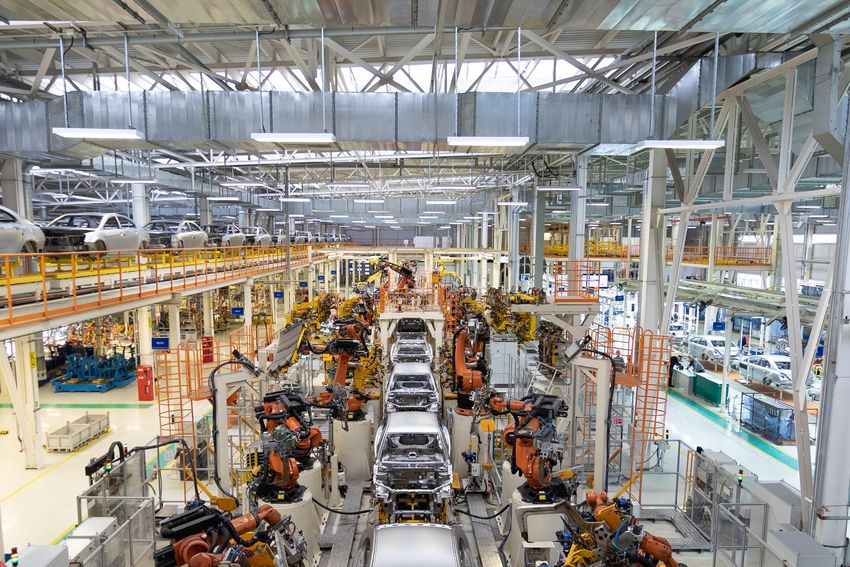Setting up an automobile manufacturing plant is a massive and capital-intensive endeavor that involves precise planning, heavy machinery, skilled manpower, and automated systems. From crafting car bodies to assembling powertrains and finishing with paint, each stage demands specialized equipment. 🧰⚙️
Whether you’re an entrepreneur, engineer, investor, or student, this comprehensive guide will walk you through the complete set of machines and equipment needed to build and run a modern automobile factory. 🏭📘
🏗️ 1. Plant Layout and Infrastructure 🧱
Before installing machines, it’s crucial to design a plant layout that supports lean manufacturing and smooth material flow. The plant is generally divided into:
-
Stamping Shop
-
Body Shop
-
Paint Shop
-
Assembly Line
-
Testing and Quality Control
-
Warehousing and Logistics
Let’s explore the machinery required in each department. 🧾🔍
🛠️ 2. Stamping Shop – Shaping the Car Body 🏋️♂️
The stamping shop is where flat sheets of metal are formed into automotive panels like hoods, doors, and roofs. This is the first step in production.
🧩 Key Machinery:
-
Hydraulic & Mechanical Presses 🏋️♂️
For cold pressing sheet metal into predefined shapes using dies. -
Press Feeders and Decoilers 🔁
Automatic feeders that unroll and feed metal coils into presses. -
Die and Tool Handling Systems 🔧
Systems for moving and maintaining heavy dies. -
Laser Cutting Machines 🔦
For precision cutting of sheet metal before forming.
⚙️ Outcome:
Formed body panels that are ready for welding and assembly.
🔩 3. Body Shop – Joining the Skeleton 🛠️
In the body shop, various panels are welded together to form the vehicle frame (body-in-white or BIW).
🧩 Key Machinery:
-
Robotic Welding Arms 🤖
MIG, TIG, and spot welding robots for fast, uniform joints. -
Spot Welding Guns ⚡
For joining metal panels with minimal deformation. -
Jigs and Fixtures 📐
To hold panels in exact positions during welding. -
Conveyor Systems 🚃
For moving body shells across welding stations. -
Fume Extractors and Ventilation Units 💨
To remove welding fumes and ensure worker safety.
⚙️ Outcome:
A fully welded car shell, ready for corrosion treatment and painting.
🎨 4. Paint Shop – Protecting and Beautifying 🖌️
One of the most expensive and complex areas, the paint shop ensures vehicles are corrosion-resistant and aesthetically appealing.
🧩 Key Machinery:
-
Pretreatment & Electrocoating Tanks 🧪
For rust-proofing using phosphate and e-coating processes. -
Paint Booths with Robots 🤖🎨
Robotic arms spray base and clear coats in dust-free environments. -
Curing Ovens 🔥
Bake paint onto the surface at controlled temperatures. -
Sealing and Underbody Coating Machines 💦
Apply sealants to prevent leaks and protect the underside. -
Air Handling Units & Filtration Systems 🌬️
Maintain clean, ventilated air in the paint booth.
⚙️ Outcome:
A glossy, durable, and colorful vehicle body.
🔧 5. Assembly Line – Bringing It All Together 🧩🚗
This is where mechanical and electrical components are installed into the painted body shell. Think engines, transmissions, seats, electronics, and more.
🧩 Key Machinery:
-
Overhead and Floor Conveyors 🚃
Move cars from one assembly stage to another. -
Torque-controlled Power Tools 🔧
For consistent tightening of bolts and screws. -
Engine and Transmission Assembly Stations 🛞
Sub-assembly zones for drivetrain units. -
Robotic Arm Installers 🤖
For fitting windshields, dashboards, doors, etc. -
Pick and Place Robots 🤖📦
Automate parts handling and positioning. -
Barcode and RFID Scanners 📡
Track assembly progress and parts logistics.
⚙️ Outcome:
A fully assembled, functioning automobile ready for inspection.
🧪 6. Testing & Quality Control – Assuring Perfection 🔍✅
Before shipping, each vehicle undergoes rigorous testing to ensure performance, safety, and quality.
🧩 Key Machinery:
-
Rolling Road Dynamometers 🛣️
Simulate driving to test engine, brakes, and gearbox. -
Headlight Alignment Tools 💡
Ensure proper illumination and angle of headlights. -
Brake and Suspension Testers 🛑
Evaluate safety-critical systems. -
Water Leak Test Chambers 💧🚿
Simulate rainfall to check for leaks. -
Emission Testing Equipment 🌫️
Measure tailpipe emissions per regulatory standards. -
End-of-Line Diagnostic Tools 📲
Scan and verify electronic control units (ECUs).
⚙️ Outcome:
Roadworthy vehicles that meet quality and regulatory standards.
🏷️ 7. Auxiliary & Support Equipment 🧰🏗️
In addition to the main production line, several support systems are essential for smooth operations.
🧩 Key Machinery:
-
Compressed Air Systems 💨
Power pneumatic tools and systems. -
Material Handling Equipment 🦾
Forklifts, AGVs, cranes for parts movement. -
Energy Supply Units ⚡
Power panels, UPS systems, and generators. -
CNC Machines and Tool Rooms 🛠️
For maintenance and die production. -
IT & Automation Systems 🖥️
SCADA, PLCs, MES (Manufacturing Execution Systems). -
Fire Safety and Waste Management Systems 🔥♻️
Safety-critical installations for environment and compliance.
💸 Estimated Investment and Cost Breakdown
Setting up a full-scale automobile plant can range from $100 million to several billion USD, depending on:
-
Production capacity (e.g., 50,000 vs 500,000 cars/year)
-
Level of automation (manual vs robotic)
-
Scope (passenger cars vs trucks)
-
Geography and regulations
A mid-size plant may require:
-
Stamping line: $10M–$25M
-
Paint shop: $20M–$40M
-
Assembly line: $15M–$30M
-
Automation & robotics: $10M+
-
Testing & QC: $5M–$10M
📈 Trends in Modern Automobile Manufacturing
-
Industry 4.0 Integration 🧠🤖: IoT, AI, and cloud systems for real-time monitoring.
-
Green Manufacturing 🌱: Using eco-friendly paints, waste recycling, and renewable energy.
-
EV-Specific Machinery 🔋: Battery pack assembly, electric drivetrain integration.
-
3D Printing 🖨️: Rapid prototyping and small-batch part production.


